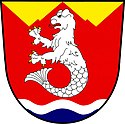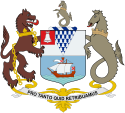Fischgeschwänzt
Der Begriff fischgeschwänzt ist ein Fachausdruck in der Heraldik und wird bei der Wappenbeschreibung verwendet, wenn Menschen oder Wappentiere von der Hüfte abwärts mit einem Fischschwanz im Wappen dargestellt werden, der auch gespalten sein kann, wie es bei der Meerfrau vorkommt.
Zu den fischgeschwänzten Gestalten sind Tritonen, Seepferde, Fischgreif, Seelöwe, Meerfrau, Wasserfrau und andere Phantasiegestalten hinzuzurechnen. In älteren heraldischen Schriften werden Tiere mit Fischschwanz auch Mörwurm genannt.[1]
Hase, fischgeschwänzt (Stadt- und Landgemeinde Parchwitz (Prochowice), Polen)[2]
zwei fischgeschwänzte Löwen als Schildhalter im Wappen des Kent County Council
fischgeschwänzter Löwe im Wappen der NL-Provinz Flevoland
zwei fischgeschwänzte Seepferde als Schildhalter im Wappen von Almere
fischgeschwänzter Löwe im Wappen von Burgas (Bulgarien)
Fischgeschwänztes Pferd im Oberwappen und als ein Schildhalter (Belfast)
fischgeschwänzter Hund (Hundfisch)[2]
Wądroże Wielkie: Einhorne als zwei fischgeschwänzte Schildhalter (Einhornfisch)[2]
Literatur
- Gert Oswald: Lexikon der Heraldik. VEB Bibliographisches Institut, Leipzig 1984.
Einzelnachweise
Auf dieser Seite verwendete Medien
Coat of arms of Kent County Council, granted 17 october 1933. Text from[1]: "The arms were officially granted on 17 October 1933 and re-confirmed in 1975. The white horse of Kent is supposedly the old symbol for the Saxon kingdom of Kent, dating from the 6-8th century. The crest shows a mural crown, which symbolises the many castles in the county, as well as the independent Saxon kingdom of Kent. The sails are symbols for the strong ties of the county with the sea and stand for the navy, the mercantile marine and fisheries.The sea lions are also a symbol for the strong ties with the navy, the lion being the British lion. The sea lions also symbolise that Kent is the frontier of Britain with continental Europe. The left supporter wears the arms of the Cinque Ports, five harbour cities that had to provide support for the English navy until modern times. Four of these cities are in Kent. The arms are three lions with ship hulls as tails. The right supporter wears a shield with the arms of the Archbishopric of Canterbury, founded in 597 by St. Augustine. Canterbury is in Kent. The motto means 'unconquered'. In 1067, shortly after the Norman Conquest (1066, as every schoolboy knows), a detachment of Kentishmen ambushed the newly crowned King William and surrounded him. In return for his life, he promised that the county would be able to keep its ancient privileges - thus Kent was the only part of England unconquered by the Normans (that is, according to legend). "
Coat of arms of Burgas, Bulgaria, consists of a shield with sea dragon, grasping a tower, three ships on top the shield. Colours: shield - royal blue, dragon and ships - yellow or gold, sails and tower - white, all black borders.
Coat of arms of Zarasai (Lithuania)
Coat of arms of the Dutch municipality of Almere.
Coat of arms with "sea-lion"
Autor/Urheber:
- derivative work: Pbroks13 (talk)
- Arms-merseyside.jpg: HeraldicBot
Arms of Merseyside Metropolitan County Council.



















